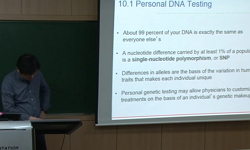Dental pulp is a highly vascularized tissue requiring adequate blood supply for successful regeneration. In this study, we investigated the functional role of stem cells from human exfoliated deciduous teeth (SHEDs) as a perivascular source for in viv...
http://chineseinput.net/에서 pinyin(병음)방식으로 중국어를 변환할 수 있습니다.
변환된 중국어를 복사하여 사용하시면 됩니다.
- 中文 을 입력하시려면 zhongwen을 입력하시고 space를누르시면됩니다.
- 北京 을 입력하시려면 beijing을 입력하시고 space를 누르시면 됩니다.



In Vivo Angiogenic Capacity of Stem Cells from Human Exfoliated Deciduous Teeth with Human Umbilical Vein Endothelial Cells
한글로보기https://www.riss.kr/link?id=A102901852
- 저자
- 발행기관
- 학술지명
- 권호사항
-
발행연도
2016
-
작성언어
English
- 주제어
-
등재정보
KCI등재,SCOPUS,SCIE
-
자료형태
학술저널
-
수록면
790-796(7쪽)
- 제공처
-
0
상세조회 -
0
다운로드
부가정보
다국어 초록 (Multilingual Abstract)
Dental pulp is a highly vascularized tissue requiring adequate blood supply for successful regeneration. In this study, we investigated the functional role of stem cells from human exfoliated deciduous teeth (SHEDs) as a perivascular source for in vivo formation of vessel-like structures. Primarily isolated SHEDs showed mesenchymal stem cell (MSC)-like characteristics including the expression of surface antigens and in vitro osteogenic and adipogenic differentiation potentials. Moreover, SHEDs were positive for NG2, ${\alpha}$-smooth muscle actin (SMA), platelet-derived growth factor receptor beta ($PDGFR{\beta}$), and CD146 as pericyte markers. To prove feasibility of SHEDs as perivascular source, SHEDs were transplanted into immunodeficient mouse using Matrigel with or without human umbilical vein endothelial cells (HUVECs). Transplantation of SHEDs alone or HUVECs alone resulted in no formation of vessel-like structures with enough red blood cells. However, when SHEDs and HUVECs were transplanted together, extensive vessel-like structures were formed. The presence of murine erythrocytes within lumens suggested the formation of anastomoses between newly formed vessel-like structures in Matrigel plug and the host circulatory system. To understand underlying mechanisms of in vivo angiogenesis, the expression of angiogenic cytokine and chemokine, their receptors, and MMPs was compared between SHEDs and HUVECs. SHEDs showed higher expression of1VEGF, SDF-$1{\alpha}$, and $PDGFR{\beta}$ than HUVECs. On the contrary, HUVECs showed higher expression of VEGF receptors, CXCR4, and PDGF-BB than SHEDs. This differential expression pattern suggested reciprocal interactions between SHEDs and HUVECs and their involvement during in vivo angiogenesis. In conclusion, SHEDs could be a feasible source of perivascular cells for in vivo angiogenesis.
동일학술지(권/호) 다른 논문
-
Viral Inhibition of PRR-Mediated Innate Immune Response: Learning from KSHV Evasion Strategies
- Korean Society for Molecular and Cellular Biology
- Lee, Hye-Ra
- 2016
- KCI등재,SCOPUS,SCIE
-
Epigenetic Changes in Neurodegenerative Diseases
- Korean Society for Molecular and Cellular Biology
- Kwon, Min Jee
- 2016
- KCI등재,SCOPUS,SCIE
-
- Korean Society for Molecular and Cellular Biology
- Zhang, Guo Hua
- 2016
- KCI등재,SCOPUS,SCIE
-
- Korean Society for Molecular and Cellular Biology
- Dua, Pooja
- 2016
- KCI등재,SCOPUS,SCIE




 ScienceON
ScienceON


